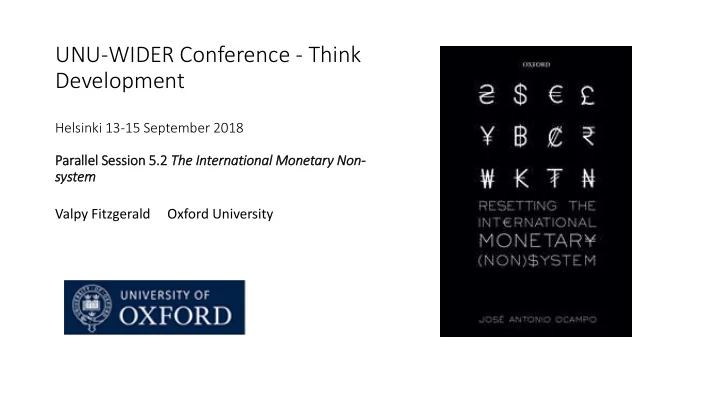

UNU-WIDER Conference - Think Development Helsinki 13-15 September 2018 Paralle lel Ses ession 5.2 .2 The e In Intern rnational Monetary ry Non- system Valpy Fitzgerald Oxford University
Resetting the In International Monetary ry Non-system • Outstanding integration of history and policy; fresh insight into a much debated topic from the viewpoint of smaller countries. • Contains three main elements: a. (Non)system International Monetary System Since Bretton Woods; The Provision of Global Liquidity; The Global Reserve System; Global Monetary Cooperation; the Exchange Rate System b. Management Capital Account Liberalization and Management; Resolution of Balance of Payments Crises; Emergency Financing and Debt Workouts c. Reform The Governance of the International Monetary System; Reforming the (Non)System • Provokes an important academic and policy debate - starting here!
Two crucial JAO graphs: collective versus individual insurance against financial shocks
JAO’s bold institutional proposals • New global reserve system (active use of SDRs and broad currency basket) • Better G20 macroeconomic coordination (includes exrate target zones) • Improved crisis management (capflows regulation, unconditional facilities, debt workout) • Strengthened international governance (representative IMF, GECC, multilayered)
So where do these shocks come from? • No longer a Bretton Woods world where public flows dominate and private flows are registered and controlled • Asset demand crucial; as opposed to looking just at asset supply (liability volume, quality i.e. EM debt) • Balance sheet approach; every liability is somebody’s asset. So IMF etc support is changing asset ownership and reconfiguring investors’ asset structure as well as EM’s liability structure. • Key issue is then not just ‘fundamentals’ (whatever these might be) of the liabilities but also crucially contagion, uncertainty, return on other assets and above all risk appetite/aversion from the investors’ point of view.
Private market capital flows (FDI = intra firm flows) data and commentary from IMF/GFSR • [graph]
The demand for emerging market assets depends as much on investors’ home market conditions as it does on EM ‘fundamentals’ The demand function for emerging market assets ( f ) in a home investor ’ s portfolio ( P ) at time ( t ) is − − 2 f h [ E ( r ) E ( r )] / R = + + + h hf f t t 1 t t 1 P − − t 2 2 2 2 f h f h where r is the return on home and EM ( h, f ) assets, R is the parameter of relative risk 2 2 aversion, and are the respective variances of returns, and is their covariance. f h hf Thus the demand for emerging market assets depends in part on ‘fundamentals’ ( 2 r and ) f f but also on home - or other foreign – market conditions such as risk aversion and home 2 r and volatility ( R, ) and the correlation between different markets ( ) which h h hf underpins ‘ contagion ’ . All of which vary strongly and rapidly causing ‘ external shocks ’ . The empirical evidence indicates that the latter is at least as important as the former; especially during crises (when both risk aversion and market covariance rise).
Volatility in return/price; comovement and regional shocks
Risk aversionhow much the market thinks the S&P 500 Index will fluctuate in the 30 days from the time of each tick of the VIX Index. an indication of the fair market price of expected volatility at particular points in time
What does this private balance sheet/asset demand approach imply for JAO’s proposals? • Reveals the systemic instability of private capital flows and how much/little the international financial system does to stabilise these (the asset demand side) as opposed to compensate with reserve lending, capital controls etc (asset supply side). • Basically the present approach means swapping (or standing credibly ready to swap) the assets private investors do not want at that crisis moment for ones that they do, until normal conditions return. No attempt to counter origins of the shock. • The solution lies partly in G20 macro-financial coordination to reduce ‘home’ fluctuations (as JAO suggests, but what authority could a GECC have without fiscal coordination - look at the Eurozone?) but further, implies greater concern for their externalities
Possible elements of a demand-side approach • ‘ Resegmentation ’ of large/vulnerable asset classes to ensure longer - term holdings (reducing effect of holders with fluctuating risk appetite); combined with market-making obligations for bond issuers (increasing liquidity and thus reducing perceived resale risk) • Redefinition of LoLR function of IMF etc in terms of provision of market liquidity and thus reduce market uncertainty as opposed to debt rollovers or BoP loans which cannot ever be truly ‘automatic’. • Domestic bank regulation (to avoid balance sheet currency mismatch) may be the most effective form of capital controls. Extension of these regulations to large domestic firms with significant external exposure.
Recommend
More recommend